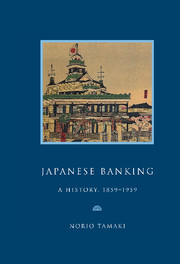Book contents
- Frontmatter
- Contents
- Preface
- Genealogy of leading Japanese banks, 1859–1959
- List of abbreviations
- Map
- Part I A bankrupt Shogunate, 1859–1868
- Part II The Meiji Restoration: monetary confusion and banking experiments, 1868–1881
- Part III Matsukata, the wizard of Japanese banking, 1881–1897; the Yokohama Specie Bank (1880) and the Bank of Japan (1882)
- Part IV The Japanese on the London money market, 1897–1911
- Part V War, the Japanese boom years, 1911–1919
- Part VI Crisis and the road to war, 1919–1937
- Part VII Complete commitment, struggle and defeat, 1937–1945
- Historical background
- 25 War budgets and the mobilisation of national resources, 1937–1943
- 26 Extraordinary banking business during the national emergency, 1941–1945
- 27 Crisis, 1945
- Part VIII American ‘democratisation’ and the search for growth, 1945–1959
- An extraordinary century, 1859–1959
- Appendices
- Notes
- Bibliography
- Index
25 - War budgets and the mobilisation of national resources, 1937–1943
Published online by Cambridge University Press: 03 February 2010
- Frontmatter
- Contents
- Preface
- Genealogy of leading Japanese banks, 1859–1959
- List of abbreviations
- Map
- Part I A bankrupt Shogunate, 1859–1868
- Part II The Meiji Restoration: monetary confusion and banking experiments, 1868–1881
- Part III Matsukata, the wizard of Japanese banking, 1881–1897; the Yokohama Specie Bank (1880) and the Bank of Japan (1882)
- Part IV The Japanese on the London money market, 1897–1911
- Part V War, the Japanese boom years, 1911–1919
- Part VI Crisis and the road to war, 1919–1937
- Part VII Complete commitment, struggle and defeat, 1937–1945
- Historical background
- 25 War budgets and the mobilisation of national resources, 1937–1943
- 26 Extraordinary banking business during the national emergency, 1941–1945
- 27 Crisis, 1945
- Part VIII American ‘democratisation’ and the search for growth, 1945–1959
- An extraordinary century, 1859–1959
- Appendices
- Notes
- Bibliography
- Index
Summary
On 7 July 1937, the Japanese troops of Kwantung army engineered a clash with the Chinese garrison at Marco Polo Bridge, near Peking. Although a ceasefire was soon negotiated, the Japanese army used the incident as an excuse to invade deep into the Chinese heartland. Nanking, General Chang Kai Shek's capital, was invaded in December 1937 when a terrible vengeance was taken by the Japanese army against local people. The escalation of the war and the behaviour of the Japanese military forces shocked the world community. Thereafter Japan and her obedient people were committed to military aggression.
Emergency financial and monetary measures were taken on 10 September 1937. The significance of these decisions remained hidden from the Western Powers. They took the form of an Extraordinary War Expenditures Special Account, the fourth in modern Japanese history, similar to those for the Sino-Japanese and Russo-Japanese Wars and the 1919 Siberian Expedition. The Japanese government did not declare war, nor indeed were they to do so, even after the Pearl Harbor attack of December 1941, but their intentions were clear. The special war account increased from ¥2,034 million in 1937 to ¥9,487 million in 1941, covering about 70 per cent of the total war expenditure for this period, which was on average 77 per cent of the total government expenditure in the same years. The details of the government expenditure were kept secret even from the Bank of Japan. Possibly more than 80 per cent of the income was earmarked for munitions, some 15 per cent for personnel expenses and the rest for transportation.
- Type
- Chapter
- Information
- Japanese BankingA History, 1859–1959, pp. 174 - 176Publisher: Cambridge University PressPrint publication year: 1995



